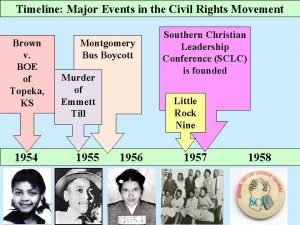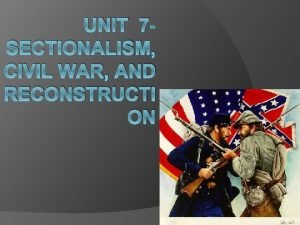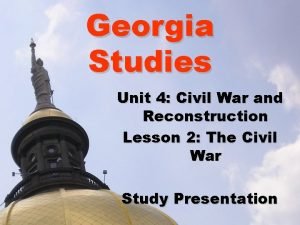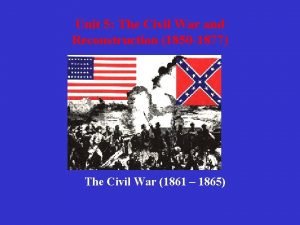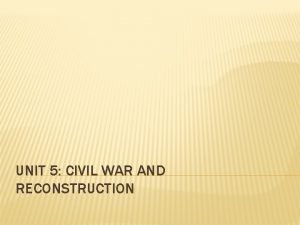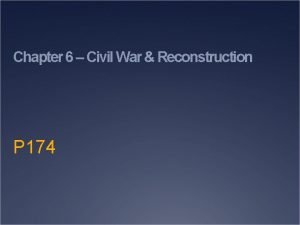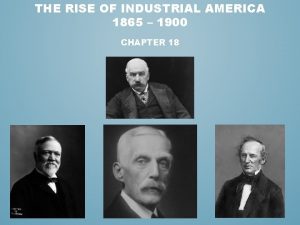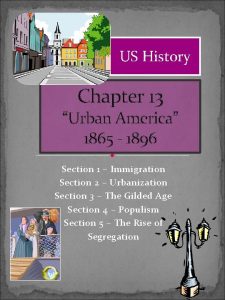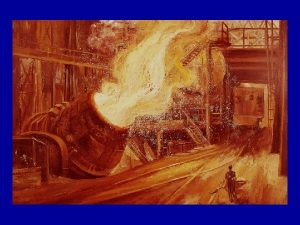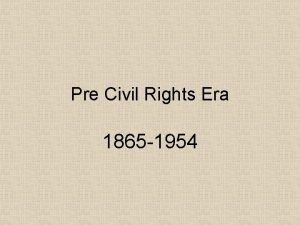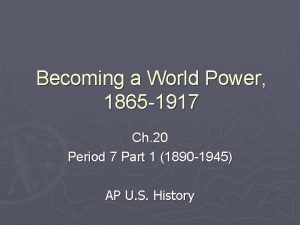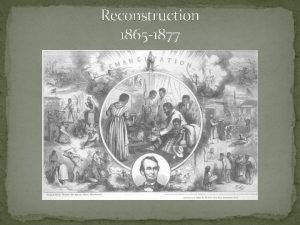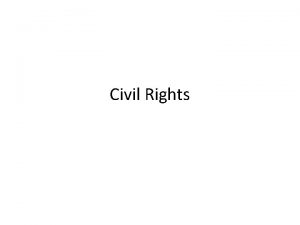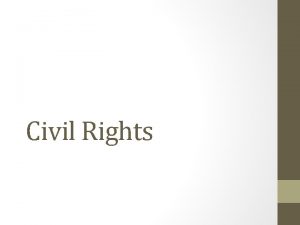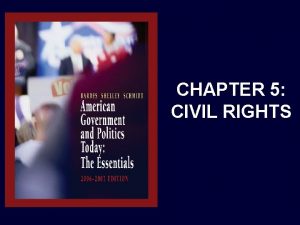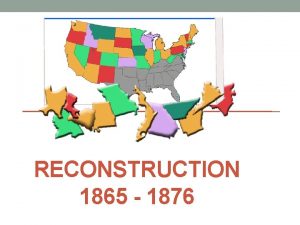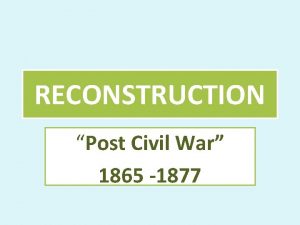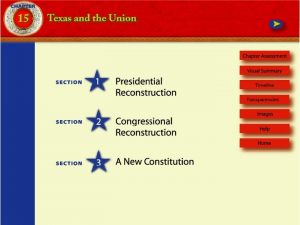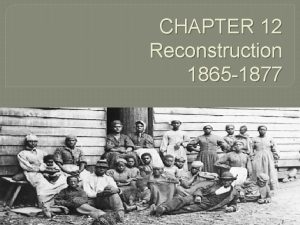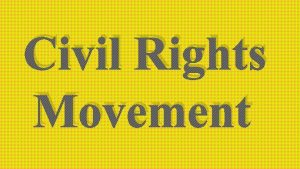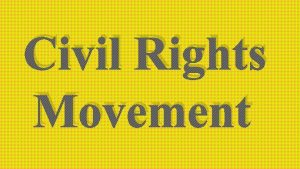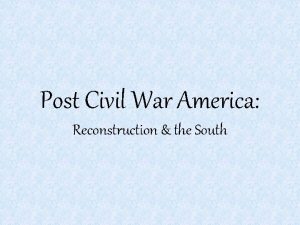Civil Rights Timeline 1865 Post Civil Wart reconstruction




























- Slides: 28

Civil Rights Timeline • 1865 – Post Civil Wart reconstruction begins; Thirteenth Amendment to the US Constitution outlaws slavery • 1868 – Fourteenth Amendment defines African Americans as citizens, guaranteeing due process and equal protection under the laws • 1870 – Fifteenth Amendment extends suffrage (the right to vote) to African American males

Civil Rights Timeline • 1896 – Plessy v. Ferguson ruling institutionalizes racial segregation by allowing “separate but equal” facilities • 1910 s – “The Great Migration” • 1917 -1918 – US participates in WWI • 1919 – “Red Summer” race riots break out • 1920 – Nineteenth Amendment grants women the right to vote

The Emmett Till Story

“I was tired and sat in the first available seat. ” Rosa was tired of the mistreatment, racism, segregation, and Jim Crow laws she and other African-Americans had endured for years as she sat looking out the window … December 1, 1955

“The only thing Rosa Parks thought about was the boy, Emmett Till. ” The bus driver told her to move or I’ll call the police. She said “Call them”.

Emmett Till Emmett spent time begging his mother to let him go visit relatives in Mississippi. His mother finally relented and told him to “Be careful and bow to a white person and do it willingly. ”

Emmett & Mom Emmett and Mamie Till

Reverend Moses Wright Moses, Emmett’s granduncle, was excited to have him come for a visit. On August 20, 1955, Emmett and his 17 year old cousin, Curtis, boarded a train bound for Money, Mississippi.

Bryant Grocery Where the “crime” took place. The store was owned by whites but serviced mostly black farmers and sharecroppers.

Carolyn Bryant When a group of black teenagers – Emmett included, arrived at the store, Emmett had been bragging about his experiences with girls in Chicago. Emmett then struck up a conversation with Carolyn Bryant.

What happened next? There have been many versions since the 50 s. Some accounts say Emmett told Mrs. Bryant… “I’ve got something for you baby”. Others say he just uttered crude remarks. Carolyn testified at the trial that he said “What’s the matter baby, can’t you take it? You needn’t be afraid of me. ” His friends pulled Emmett away from the store but he whistled as he left and say “Bye baby”.

What happened next? The others were now truly afraid. Having grown up in Mississippi they knew what constituted unacceptable behavior in race relations. A black youth making any type of sexual advances to a white woman was a blatant and dangerous violation of the unspoken code of the south. There could only be one punishment. - Death!

Tallahatchie River • What happened that night? • It is said that several men went out to find ‘that boy’. • Rev. Moses said, “He was put in a pickup truck and driven off into the night” • “A young white boy who was fishing found the body hung up on a snag in the river three days later. ” • The body was weighted down with a 80 pound fan. It was shot, one eye was hanging out of it’s socket, the neck broken, teeth knocked out, and barbed wire wrapped around the neck.

Emmett’s Funeral The coffin was intentionally left open, a decision made by Mamie Till who wanted the world to see what they had done to her son.

Courtroom Within two hours the all white jury came back with a verdict against the men who were on trial – “NOT GUILTY”

Fair Trial?

J. W. Milam (left) and Roy Bryant (right) and their wives celebrate the verdict of not guilty! J. W. Milam (left), Roy Bryant and their wives exult in the verdict

Emmett’s Grave Marker

Mamie Till today

Today • The case still is in the news. • “The trial was a farce and nothing has been done since the 50 s”, says the FBI • Today the story has been made into a movie – “The story of Emmett Louis Till”. It tells of evidence never given at the trial.

Lynching v. Murder • Lynching = community making communal decision to attack someone • Murder = individual decision to attack someone

Jesse Washington 1916 • Jesse Washington was a 17 year old boy in Waco, Texas accused of rape and murder of a white woman (Lucy Fryer) • He was dragged out of the court by observers and lynched in front of Waco's city hall. • Over 10, 000 spectators, including city officials and police, gathered to watch the attack.

• There was a celebratory atmosphere at the event, and many children attended during their lunch hour. • He was tortured and burned, and then his body was paraded around the town. • A professional photographer took pictures as the event unfolded, providing rare imagery of a lynching in progress. • The pictures were printed and sold as postcards in Waco.

Aftermath of Washington’s • Although the lynching was supported by many Waco residents, it was condemned by newspapers around the United States. • The National Association for Advancement of Colored People (NAACP) hired Elizabeth Freeman to investigate; she conducted a detailed probe in Waco, despite the reluctance of many residents to speak about the event. • After receiving Freeman's report on the lynching, NAACP co-founder and editor W. E. B. Du Bois published an indepth report featuring photographs of Washington's charred body in The Crisis, and the NAACP featured his death in their anti-lynching campaign. • Even was nicknamed “Waco Horror”

Washington v. Till Cultural shift from 1916 -1955 1. WWI - WWIII = Patriotic Rhetoric (it’s not American to do this) 2. Global audience, global self consciousness (TV, photo, film) 3. Rise of the media – visual media

Civil Rights Timeline Continued 1865 – Ki Klux Klan is formed in Pulaski, Tennessee • Six Confederate veterans from Pulaski, Tennessee created the original Ku Klux Klan on December 24, 1865, during the Reconstruction of the South after the Civil War.

Civil Rights Timeline Continued • 1958 – Temple Bombing Atlanta, GA – Fifty sticks of dynamite exploded at the Hebrew Benevolent Congregation, Atlanta's oldest and most prominent synagogue, more commonly known as "the Temple” • 1963 – Birmingham Bombing (16 th Street Baptist Church) – Was one of the deadliest acts of violence to take place during the Civil Rights movement and evoked criticism and outrage from around the world. A bomb exploded in the stairwell of Sixteenth Street Baptist Church killing four girls and injuring dozens of others in the assembly.

 Civil rights timeline of events
Civil rights timeline of events Civil rights and civil liberties webquest
Civil rights and civil liberties webquest Civil war and reconstruction achieve 3000 answer key
Civil war and reconstruction achieve 3000 answer key Unit 4: civil war and reconstruction
Unit 4: civil war and reconstruction Unit 5 civil war and reconstruction
Unit 5 civil war and reconstruction Civil war and reconstruction study guide
Civil war and reconstruction study guide Reconstruction vocabulary words
Reconstruction vocabulary words Chapter 6 civil war and reconstruction
Chapter 6 civil war and reconstruction Positive vs negative rights
Positive vs negative rights Negative right
Negative right What is negative right
What is negative right Littoral rights
Littoral rights Negative rights
Negative rights Duties towards self
Duties towards self Positive rights vs negative rights
Positive rights vs negative rights Legal rights vs moral rights
Legal rights vs moral rights Regionalism in literature
Regionalism in literature Becoming a world power 1865-1917
Becoming a world power 1865-1917 Gregor mendel 1865
Gregor mendel 1865 Four features of industrial manufacturing (1865-1900)
Four features of industrial manufacturing (1865-1900) Impressionism art movement characteristics
Impressionism art movement characteristics Urban america 1865 to 1896
Urban america 1865 to 1896 Industrialization (1865 to 1901 worksheet answers key)
Industrialization (1865 to 1901 worksheet answers key) Where did the term “impressionism” come from?
Where did the term “impressionism” come from? 15 th ammendment
15 th ammendment Becoming a world power 1865-1917
Becoming a world power 1865-1917 Hollywood silver fox farm v emmett
Hollywood silver fox farm v emmett 1865 to 1900 inventions
1865 to 1900 inventions Whats the compromise of 1877
Whats the compromise of 1877
